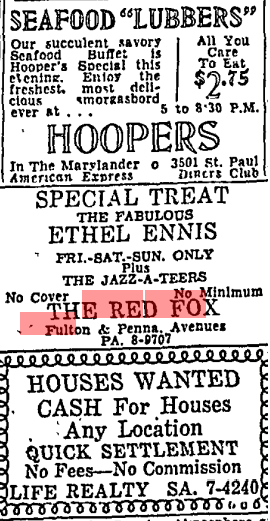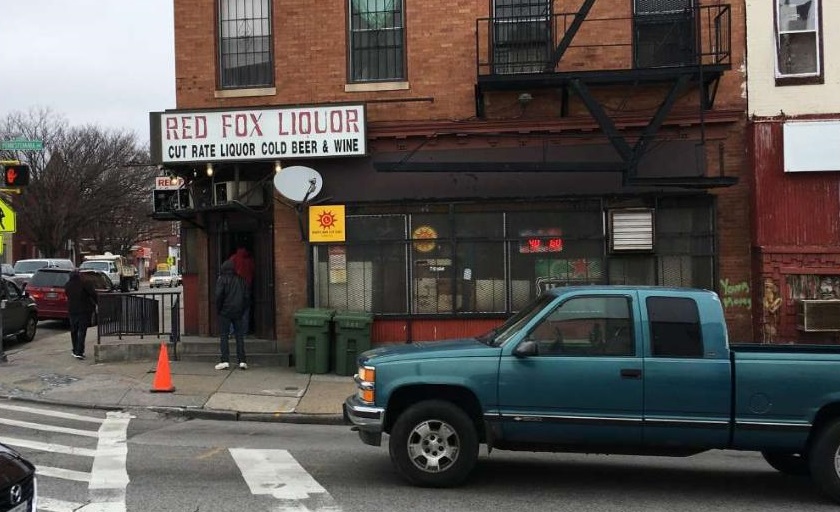Welcome back to Booze News!
Until last month, recent inspection information was essentially unavailable to the public. The public paper files at the Liquor Board’s offices contained only inspection reports from several years ago, as we saw in our Waverly Tavern post; the more recent inspection reports were either in the Liquor Board’s online system, which was not publicly available, or in paper copies that were in tall unsorted stacks and file boxes. However, luckily for community members, the Liquor Board has begun uploading its inspection reports to its online library, for communities and others who are interested. This is a huge and much needed step forward in providing public access to important information about liquor licensed establishments! (The online library, for whatever reason, is pretty finicky, and it times out and crashes often, so be prepare to reload pages to find what you’re looking for!)
This week, Booze News will focus on Red Fox Liquors, a 7-day package goods store and tavern at the corner of Pennsylvania Avenue and North Fulton Avenue, in the Penn North neighborhood. In the 1960s and 1970s, famed Baltimore jazz singer Ethel Ennis, known as “The First Lady of Jazz,” performed regularly at the Red Fox Lounge, as it was previously known. The Red Fox is no longer permitted to host live entertainment and dancing, according to its liquor license, although it’s unclear when that change took place. See below a clip from the Baltimore Sun on October 20, 1967, advertising an Ennis performance at the Red Fox.

Recently, the Baltimore Police Department named the Pennsylvania and Fulton Avenue intersection a “hot spot” for crime; the city has concentrated extra police and city agency resources in the area, with the goal of crime reduction.
In the spring of 2017, community members submitted a protest of renewal petition of Red Fox Liquors’ liquor license, arguing that the tavern contributes to drug trafficking and violent crime. The license was renewed when only a couple of community members showed up to the public hearing to testify about their concerns about the tavern.

In our last post, we took a look at a few old paper inspection reports for Waverly Tavern, so let’s dive into a little more detail this week. What kind of information does the Liquor Board collect in an inspection? It varies depending on whether the inspection is categorized as a routine inspection or a compliance inspection.
Compliance inspections are investigations of a violation of law.
Nine times out of ten, the Liquor Board’s investigations are either related to sales to minors or to violations of the law that requires that a tavern keep its on-site bar open whenever its package goods operation is open.
Here are some of the fields in a compliance inspection report.
Open/closed status: This is helpful information when trying to determine whether a liquor license has expired, which occurs after 180 days of closure.
Clean and free of debris
Trader’s license: A trader’s license is an annual license from the State Department of Assessments and Taxation (SDAT) that allows a business to sell things.
Alcohol Awareness Certification: One owner or employee per license is required to complete an alcohol training program and make their certification available to the Liquor Board if requested. However, that alcohol-trained owner or employee is not required to be on the premises. Also, the alcohol training certificate is good for four years, and it is checked annually through the license renewal process. Does this certificate then need to be checked quarterly by a Liquor Board inspector?
Fire safety checks: The form asks whether the exits are marked and unobstructed and for the fire capacity of both inside and outside seating areas. These are good questions to ask, but why would capacities need to be checked quarterly?
Violations noted:/Instructions given: The inspector lists any violations of the Rules and Regulations of the Liquor Board that s/he observes and any instructions given to the licensee, if relevant.
Inspector’s comments/photos taken: On the vast majority of inspection reports that I have ever seen, the inspector’s comments are limited to “good” or “ok” and the photo taken is of the outside of the business (like the photo above.)
Routine Inspections – Routine inspections are not investigations. They usually happen during daytime hours and include the above fields, plus these additional considerations:
Location & shape of bar: Does this need to be inspected and noted quarterly? It’s my understanding that licensees do not often change the location and shape of their bar. They’re required to get the commission’s approval anyway, before making any alterations.
Condition of bar area/floors, hot water, disinfectant solution, three compartment sink: all important things to have when serving drinks to the public.
Bulletproof partitioning, separate package goods department, separate package goods store: Again, these are not things that change quarterly.
Bar/tavern open and operating: Behind sales to minors, this is the second largest source of violations for the Liquor Board: tavern licenses who operate solely as package goods stores, without an open and operating bar.
Selling household/grocery: A little known Baltimore City ordinance says that a package goods store may not sell anything, not even chips or soda, to minors. This has never been enforced by any agency.
Dining area capacity, location, condition of floors, employee records, alcohol beverage information invoice numbers and dates, and description of live entertainment.
Let’s take a look at the inspection reports from 2018-2019 for Red Fox Tavern, starting with the most recent.
Click on the date to take you to the PDF of the inspection report itself.
January 24, 2019
First of all, under the name and location of the licensed premises, each inspection report lists a date and time of inspection. Confoundingly, this is not actually the date and time of the inspection; rather, it is the date and time that the inspector entered the information from the inspection into the Liquor Board’s computer system, which could be hours or days later.
This inspection took place because the inspector was required to give the licensee notice of a public hearing regarding a sale to minors. The Board held the hearing on February 7, 2019, and the licensees admitted the violation, receiving a penalty of $875. There is basically no other information here.
December 5, 2018
There is basically no information in this inspection report, other than that the establishment is “satisfactory.” Though it is a compliance inspection, it’s not clear what rule the inspectors were investigating. (It’s almost always either sales to minors or a tavern compliance check – to make sure that the bar is open whenever the carryout is.)
November 7, 2018
Red Fox Liquors passed an underage drinking check. The inspection report was put into the system a week after the inspection.
October 15, 2018
A routine inspection! Everything is satisfactory, according to the inspector. No details or comments provided.
September 25, 2018
Red Fox passed another underage drinking check. Information entered three days later. No details.
August 11, 2018
A routine inspection. The comments section says that inspectors visited Red Fox during the AFRAM festival, which was taking place at Druid Hill Park, about four blocks away. No details.
June 18, 2018
A routine inspection. The inspector comments “ok.”
May 25, 2018
The Vice Unit of the Police Department happened to be riding by Red Fox when they saw other police units investigating a homicide that had happened in front of the liquor store. They stopped and closed down the bar for the evening.
May 30, 2018
This inspection report says that the establishment is “under investigation” but provides no details about what the investigation concerns. It refers to Case # 7180510469, which does not appear to be publicly available information.
To recap!
Over the past year, the Liquor Board has been touting its increased numbers of inspections. But is the increased number of inspections a good use of limited resources and time? How many inspections take place during the day, versus at night, when communities report the most serious concerns? Is it necessary to inspect every license four times per year? If the vast majority of Liquor Board inspections show that everything is satisfactory, but public health experts show that alcohol is having a negative – and sometimes disproportionate – impact on the safety of communities, does that mean that the agency should reimagine its inspection process?
Tell us what you think below!